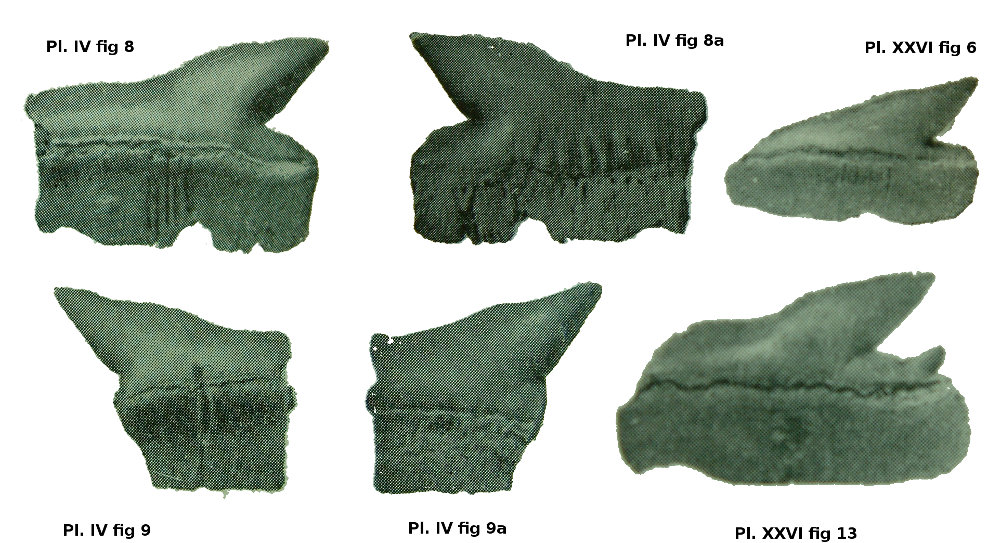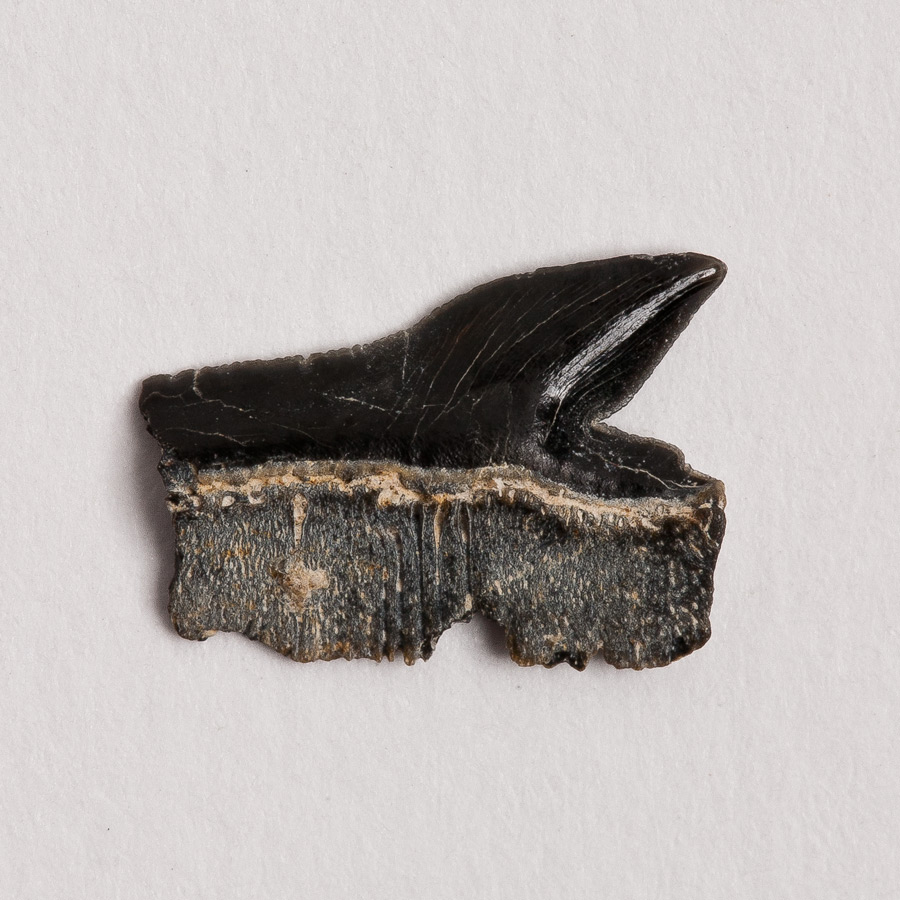Echinorhinus caspius
Glikman, 1964
Classification: Elasmobranchii Echinorhiniformes Echinorhinidae
Reference of the original description
(Sharks of Paleogene and their stratigraphic significance). «in russian». Nauka Press: 229 p., 76 fig., 31 pl. Moscou.
(Sharks of Paleogene and their stratigraphic significance). «in russian». Nauka Press: 229 p., 76 fig., 31 pl. Moscou.
Image of the original description

Echinorhinus caspius Glickman, 1964, images of the original description

Echinorhinus caspius Glickman, 1964, images of the original description
Synonyms / new combinations and misspellings
Echinorhinus cf. caspius
Echinorhinus cf. caspius
Types
Echinorhinus caspius
Lectotype: Darwin Museum: GIK No. 8057/3; Paralectotype: Darwin Museum: GIK No. 8057/4;
Echinorhinus caspius
Lectotype: Darwin Museum: GIK No. 8057/3; Paralectotype: Darwin Museum: GIK No. 8057/4;
Description by Pollerspoeck, Juergen:
Benediktinerring 34, D-94569 Stephansposching; juergen.pollerspoeck@shark-references.comCitation: Echinorhinus caspius Glikman, 1964: In: Database of fossil elasmobranch teeth www.shark-references.com, World Wide Web electronic publication, Version 01/2026
Please send your images of "Echinorhinus caspius" to info@shark-references.com

Echinorhinus caspius Glickman, 1964, lingual view, Lectotype GIK No. 8057/3 © State Darwin Museum, Moscow

Echinorhinus caspius Glickman, 1964, lingual view, Lectotype GIK No. 8057/3 © State Darwin Museum, Moscow
Distribution Geographic
type locality: Mangyshlak Peninsula, Usak-Nizy, Kasachstan [980];
other localities:
Distribution of Echinorhinidae show google map
type locality: Mangyshlak Peninsula, Usak-Nizy, Kasachstan [980];
other localities:
Distribution of Echinorhinidae show google map
Distribution Stratigraphy
Upper Eocene, Adayev Formation, Variamussium fallax zone (after GLIKMAN, 1964 [980])
Upper Eocene, Adayev Formation, Variamussium fallax zone (after GLIKMAN, 1964 [980])
Description
Original diagnosis GLIKMAN, 1964 (russian) [980]: Материал. Восемь отдельных зубов. Описание. Зубы со слабо зазубренным симфизным краем (зазубренность наблюдается у всех зубов). Вершина одна, реже за главной вершиной один некрупный дополнительный зубец. В отличие от зубов современного Е. соокеъ он отделен от главного конуса значительным интервалом. Передний зубец или отсутствует, или представлен округлым выступом, постепенно переходящим в главный конус. Главная вершина у всех зубов нового вида более широкая и менее заостренная, чем это наблюдается у Е. соокеъ; кроме того, симфизный край зуба более изогнут. Изогнутость симфизного края, однако, меньшая, чем у Е. Ъгисиз, с которым новый вид сближает также более вырезанный, чем у Е. соокеъ, симфизный край и большая ширина главных вершин. От среднеэоценового вида Е ргъзсиз АгашЬ. зубы Е. сазръиз отличаются значительно более крупными размерами и высотой корня. Местонахождения. Низы адаевской свиты, нижнии олигоцен, кол. Усак (п-ов Мангышлак); зона Уапатизшш Ыах, Армения.
WELTON, 1979 [2517] translated from the original diagnosis: (Translation by George Shkurkin): "The teeth have a weakly denticulated symphysial margin, the denticulation is observed on all the teeth. There is one cusp with a rare small cusplet behind the main cusp. In distinction from the teeth of contemporaneous Echinorhinus cookei, it is separated from the main cone (cusp) with a significant interval. The anterior denticle either is absent or is represented by a rounded prominence which gradually leads into the main cone. The main apex in all the teeth of the new species is broader and less pointed than is observed in E. cookei. In addition, the symphysial margin is, however, less then in E. brucus. The new species is closer to E. brucus in having a stronger outlined symphysial margin and a greater width of the main apex than does E. cookei. The teeth of E. caspius differ from the Middle Eocene species E. priscus Arambourg by a significantly greater dimension and by the height of the root (Glickman, 1964: 161) [980]."
Original diagnosis GLIKMAN, 1964 (russian) [980]: Материал. Восемь отдельных зубов. Описание. Зубы со слабо зазубренным симфизным краем (зазубренность наблюдается у всех зубов). Вершина одна, реже за главной вершиной один некрупный дополнительный зубец. В отличие от зубов современного Е. соокеъ он отделен от главного конуса значительным интервалом. Передний зубец или отсутствует, или представлен округлым выступом, постепенно переходящим в главный конус. Главная вершина у всех зубов нового вида более широкая и менее заостренная, чем это наблюдается у Е. соокеъ; кроме того, симфизный край зуба более изогнут. Изогнутость симфизного края, однако, меньшая, чем у Е. Ъгисиз, с которым новый вид сближает также более вырезанный, чем у Е. соокеъ, симфизный край и большая ширина главных вершин. От среднеэоценового вида Е ргъзсиз АгашЬ. зубы Е. сазръиз отличаются значительно более крупными размерами и высотой корня. Местонахождения. Низы адаевской свиты, нижнии олигоцен, кол. Усак (п-ов Мангышлак); зона Уапатизшш Ыах, Армения.
WELTON, 1979 [2517] translated from the original diagnosis: (Translation by George Shkurkin): "The teeth have a weakly denticulated symphysial margin, the denticulation is observed on all the teeth. There is one cusp with a rare small cusplet behind the main cusp. In distinction from the teeth of contemporaneous Echinorhinus cookei, it is separated from the main cone (cusp) with a significant interval. The anterior denticle either is absent or is represented by a rounded prominence which gradually leads into the main cone. The main apex in all the teeth of the new species is broader and less pointed than is observed in E. cookei. In addition, the symphysial margin is, however, less then in E. brucus. The new species is closer to E. brucus in having a stronger outlined symphysial margin and a greater width of the main apex than does E. cookei. The teeth of E. caspius differ from the Middle Eocene species E. priscus Arambourg by a significantly greater dimension and by the height of the root (Glickman, 1964: 161) [980]."
Discussion
PFEIL, 1983 [1886] and WELTON, 1979 [2517] use the wrong age for the type locality (Lower Oligocene instead of Upper Eocene).
PFEIL, 1983 [1886] and WELTON, 1979 [2517] use the wrong age for the type locality (Lower Oligocene instead of Upper Eocene).
References
Echinorhinus caspius, Echinorhinus richiardii, Echinorhinus pollerspoecki, Echinorhinus schoenfeldi, Echinorhinus cf. riepli, Echinorhinus priscus, Paraechinorhinus riepli, Echinorhinus sp., Echinorhinus pfauntschi, Echinorhinus blakei, Echinorhinus pozzii, Echinorhinus kelleyi, Echinorhinus weltoni, Echinorhinus eyrensis, Echinorhinus australis, Gibbechinorhinus lewyi, Orthechinorhinus pfeili, In Database of fossil elasmobranchteeth, www.shark–references.com, World Wide Web electronic publication, Version 04/2013

Oldest evidence of bramble sharks (Elasmobranchii, Echinorhinidae) in the Lower Cretaceous of southeast France and the evolutionary history of orbitostylic sharks. (plus Supplementary data). Cretaceous Research, 35, 81–87
DOI: 10.1016/j.cretres.2011.11.021

Zahnmorphologische Untersuchungen an rezenten und fossilen Haien der Ordnungen Chlamydoselachiformes und Echinorhiniformes. Palaeo Ichthyologica, 1, 1–315

Late Cretaceous and Cenozoic Squalomorphii of the Northwest Pacific Ocean. PhD, Univ. of California Berkeley, 553 p., 71 fig.

Paleontologic studies of the Middle Tertiary Skooner Gulch and Gallaway Formations at Point Arena, California. In A. E. Fritsche, H. Terbest, Jr., & W. W. Wornardt(eds.), The Neogene symposium. Proceedings of the Society of Economic Paleontologists and Mineralogists (Pacific Sect. Ann. Meeting, San Francisco) 137–154

(Sharks of Paleogene and their stratigraphic significance). «in russian». Nauka Press: 229 p., 76 fig., 31 pl. Moscou.
Echinorhinus caspius, Echinorhinus richiardii, Echinorhinus pollerspoecki, Echinorhinus schoenfeldi, Echinorhinus cf. riepli, Echinorhinus priscus, Paraechinorhinus riepli, Echinorhinus sp., Echinorhinus pfauntschi, Echinorhinus blakei, Echinorhinus pozzii, Echinorhinus kelleyi, Echinorhinus weltoni, Echinorhinus eyrensis, Echinorhinus australis, Gibbechinorhinus lewyi, Orthechinorhinus pfeili, In Database of fossil elasmobranchteeth, www.shark–references.com, World Wide Web electronic publication, Version 04/2013

Oldest evidence of bramble sharks (Elasmobranchii, Echinorhinidae) in the Lower Cretaceous of southeast France and the evolutionary history of orbitostylic sharks. (plus Supplementary data). Cretaceous Research, 35, 81–87
DOI: 10.1016/j.cretres.2011.11.021

Zahnmorphologische Untersuchungen an rezenten und fossilen Haien der Ordnungen Chlamydoselachiformes und Echinorhiniformes. Palaeo Ichthyologica, 1, 1–315

Late Cretaceous and Cenozoic Squalomorphii of the Northwest Pacific Ocean. PhD, Univ. of California Berkeley, 553 p., 71 fig.

Paleontologic studies of the Middle Tertiary Skooner Gulch and Gallaway Formations at Point Arena, California. In A. E. Fritsche, H. Terbest, Jr., & W. W. Wornardt(eds.), The Neogene symposium. Proceedings of the Society of Economic Paleontologists and Mineralogists (Pacific Sect. Ann. Meeting, San Francisco) 137–154

(Sharks of Paleogene and their stratigraphic significance). «in russian». Nauka Press: 229 p., 76 fig., 31 pl. Moscou.

















